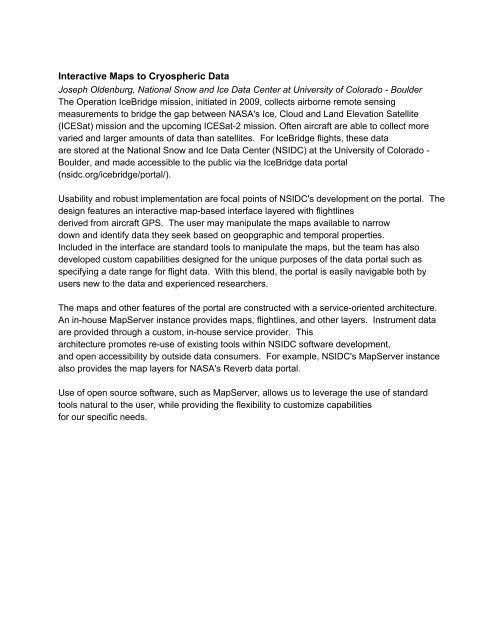FOSS4G North America Conference 2013 Preliminary Program
FOSS4G North America Conference 2013 Preliminary Program
FOSS4G North America Conference 2013 Preliminary Program
Create successful ePaper yourself
Turn your PDF publications into a flip-book with our unique Google optimized e-Paper software.
Interactive Maps to Cryospheric Data<br />
Joseph Oldenburg, National Snow and Ice Data Center at University of Colorado Boulder<br />
The Operation IceBridge mission, initiated in 2009, collects airborne remote sensing<br />
measurements to bridge the gap between NASA's Ice, Cloud and Land Elevation Satellite<br />
(ICESat) mission and the upcoming ICESat2 mission. Often aircraft are able to collect more<br />
varied and larger amounts of data than satellites. For IceBridge flights, these data<br />
are stored at the National Snow and Ice Data Center (NSIDC) at the University of Colorado <br />
Boulder, and made accessible to the public via the IceBridge data portal<br />
(nsidc.org/icebridge/portal/).<br />
Usability and robust implementation are focal points of NSIDC's development on the portal. The<br />
design features an interactive mapbased interface layered with flightlines<br />
derived from aircraft GPS. The user may manipulate the maps available to narrow<br />
down and identify data they seek based on geopgraphic and temporal properties.<br />
Included in the interface are standard tools to manipulate the maps, but the team has also<br />
developed custom capabilities designed for the unique purposes of the data portal such as<br />
specifying a date range for flight data. With this blend, the portal is easily navigable both by<br />
users new to the data and experienced researchers.<br />
The maps and other features of the portal are constructed with a serviceoriented architecture.<br />
An inhouse MapServer instance provides maps, flightlines, and other layers. Instrument data<br />
are provided through a custom, inhouse service provider. This<br />
architecture promotes reuse of existing tools within NSIDC software development,<br />
and open accessibility by outside data consumers. For example, NSIDC's MapServer instance<br />
also provides the map layers for NASA's Reverb data portal.<br />
Use of open source software, such as MapServer, allows us to leverage the use of standard<br />
tools natural to the user, while providing the flexibility to customize capabilities<br />
for our specific needs.


